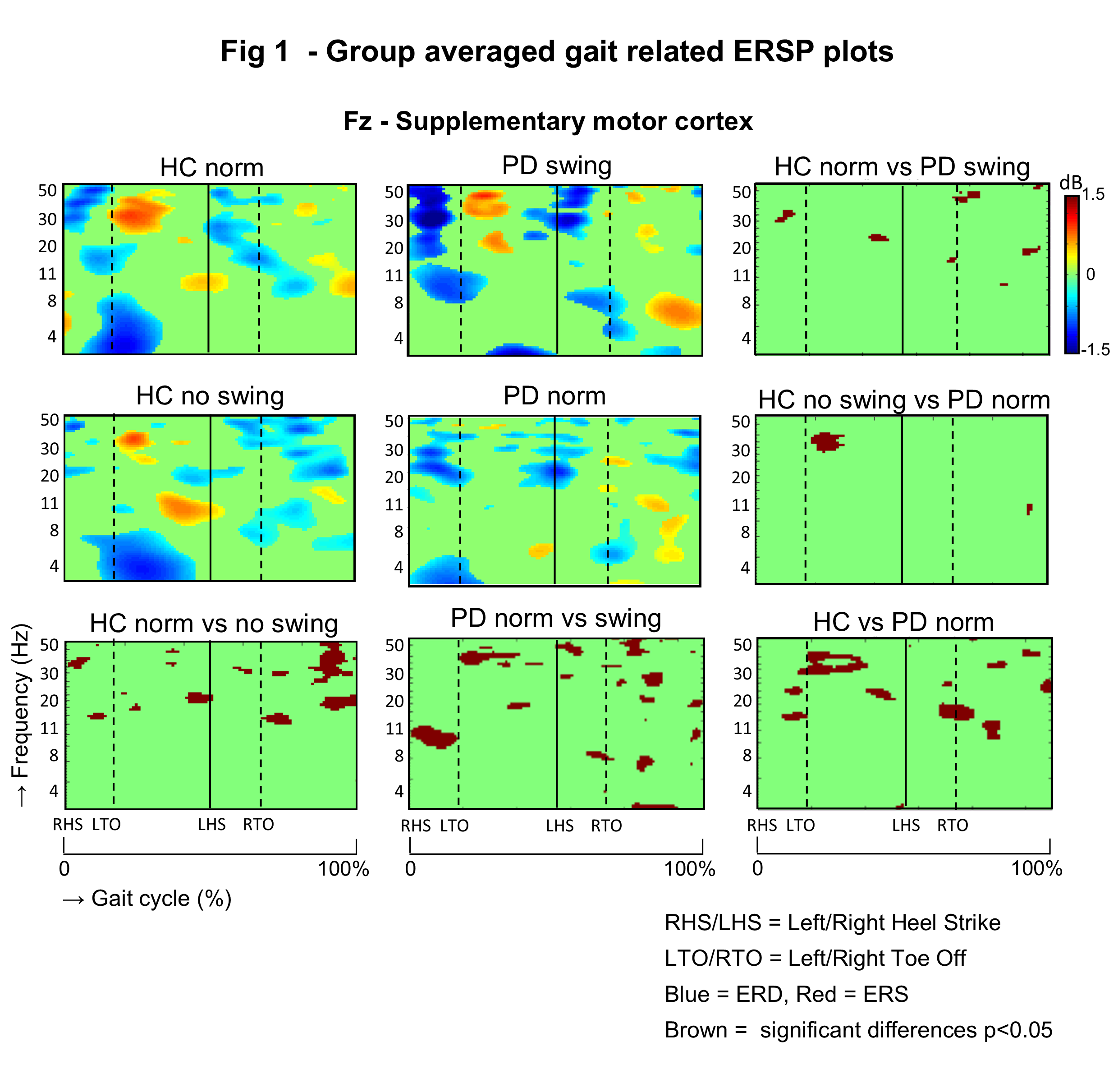Category: Parkinson's Disease: Neurophysiology
Objective: To examine whether enhanced arm swing improves Parkinsonian gait and explore the role of the supplementary motor area (SMA) in such an improvement.
Background: The SMA is implicated in stereotypic multi-limb movements such as walking with arm swing [1–3]. Gait difficulties in Parkinson’s Disease (PD), including a reduced arm swing, were indeed found to be associated with reduced SMA activity [4–6]. Gait related arm swing was proposed to serve as an SMA mediated drive force in gait control [1,4].
Method: Ambulant EEG, accelerometers and video-recordings were used to asses cortical activity and gait characteristics in 27 PD patients with self-reported gait difficulties and 35 healthy controls (HC) when walking normally overground for 150 meters (i.e. baseline). Of these two groups, 19 PD patients and 30 healthy controls additionally performed a second session, where PD patients walked with enhanced arm swing and healthy controls walked without arm swing. Power changes across the EEG frequency spectrum were assessed by Event Related Spectral Perturbation analysis of recordings from Fz over the putative SMA and gait analysis was performed.
Results: Baseline PD gait, characterized by reduced arm swing, exhibited reduced within-step Event Related Desynchronization (ERD) / Synchronization (ERS) alternation in the high beta/low gamma (20-50 Hz) frequencies at the Fz electrode, which is located over the putative SMA [figure 1]. This was accompanied by a reduced step length and gait velocity. Both EEG power modulations and gait characteristics became similar to healthy gait when PD patients walked with enhanced arm swing. Conversely, when healthy controls walked without arm swing, their alternating ERD-ERS pattern decreased, mimicking that of baseline PD gait.
Conclusion: Enhanced arm swing may serve as a driving force to overcome impaired gait control in PD patients by restoring reduced ERD-ERS alternation over the putative SMA. Accompanied by increased step length and gait velocity, this provides a neural underpinning of arm swing as an effective rehabilitation concept for improving Parkinsonian gait.
References: [1] Weersink JB, Maurits NM, de Jong BM. EEG time-frequency analysis provides arguments for arm swing support in human gait control. Gait Posture 2019;70:71–8. [2] Rouiller EM, Babalian A, Kazennikov O, Moret V, Yu XH, Wiesendanger M. Transcallosal connections of the distal forelimb representations of the primary and supplementary motor cortical areas in macaque monkeys. Exp Brain Res 1994;102:227–43. [3] Ruddy KL, Leemans A, Carson RG. Transcallosal connectivity of the human cortical motor network. Brain Struct Funct 2017;222:1243–52. [4] Weersink JB, Gefferie SR, van Laar T, Maurits NM, de Jong BM. Pre-Movement Cortico-Muscular Dynamics Underlying Improved Parkinson Gait Initiation after Instructed Arm Swing. J Parkinsons Dis 2020;10:1675–93. [5] Jacobs JV, Lou JS, Kraakevik JA, Horak FB. The supplementary motor area contributes to the timing of the anticipatory postural adjustment during step initiation in participants with and without Parkinson’s disease. Neuroscience 2009;164:877–85. [6] Jenkins I, Fernandex W, Playford E, Lees A, Frackowiak R, Passingham R, et al. Impaired activation of the supplementary motor area in Parkinson’s disease is reversed when akinesia is treated with apomorphine. Ann Neurol 1992;32:749–57.
To cite this abstract in AMA style:
J. Weersink, N. Maurits, B. de Jong. Enhanced arm swing improves Parkinson gait associated with EEG power modulations resembling those in healthy gait. [abstract]. Mov Disord. 2021; 36 (suppl 1). https://www.mdsabstracts.org/abstract/enhanced-arm-swing-improves-parkinson-gait-associated-with-eeg-power-modulations-resembling-those-in-healthy-gait/. Accessed December 16, 2025.« Back to MDS Virtual Congress 2021
MDS Abstracts - https://www.mdsabstracts.org/abstract/enhanced-arm-swing-improves-parkinson-gait-associated-with-eeg-power-modulations-resembling-those-in-healthy-gait/

